Photonic Integration: Enabling The Terabit Era
Currently, most high-speed digital optical transport is carried over 10 Gb/s waves using a pair of fibers (TX/RX). Using 160 x 10G DWDM lambdas with double density spacing at 25 GHz, a fiber pair can transport 1.6 Tb/s or half that if 50 GHz spacing is used. Growth occurs in 10G increments by adding new transponders as more bandwidth is required.
This linear approach to bandwidth growth, while workable in the short term, does not fundamentally lower the cost per bit for transport over time, nor does it improve scalability by making more efficient use of existing resources ( e.g., fiber) or reducing resource consumption ( e.g., space requirements). As optical transport bandwidth continues to grow at a compounded 50 percent to 100 percent annually, network growth cannot continue to scale on a linear basis simply by adding more optical transponders. Aside from equipment costs, the required space, power, cooling and optical couplings rapidly become unmanageable.
The cable industry is beginning to migrate to 100G core optical transport waves that greatly improve fiber utilization while lowering transponder count for equivalent bandwidth. However, transporting 100G waves requires complex optical modulation to preserve performance and increase spectral efficiency. Complex modulation requires several additional discrete optical components per lambda, so the migration to 100G waves alone does not fully address the scalability issues of increasing cost, power, space, and heat as bandwidth requirements continue to grow.
Optical networks rapidly are approaching the point where continual scaling of higher bit-rate optical lambdas using discrete optical components is reaching its limits. Photonic integration, which combines multiple optical components on a single IC, can efficiently support complex modulation schemes while decreasing component counts. By reducing hardware, power, space, cooling and reliability costs, photonic integration provides a scalable path for future growth.
Higher-Order Optical Modulation
It’s important for cable operators to migrate to 100G lambdas seamlessly on today’s 10G networks without having to re-engineer or upgrade the network, including leaving existing dispersion compensation and amplifiers in place. To meet the dual objectives of increasing bandwidth per DWDM channel and operating these lambdas on existing 10G networks, higher-order modulation is required for 100G lambdas.
Most 10G DWDM systems today use on-off keying (OOK) modulation applied to the laser light source. This is the simplest form of amplitude shift keying in which a “1” is represented by the presence of light and a “0” by its absence. OOK uses a minimal number of components, but is not spectrally efficient. Figure 1 shows a block diagram of the components required to transport an OOK optical signal. The transmitter consists of a laser and a simple OOK modulator. The receiver is even simpler, requiring only a photo detector.
When compared with lower-speed transport, 10G OOK modulation requires more transport spectrum while the bit period is shorter, which makes chromatic dispersion (CD) a more significant factor for 10G transport. Depending on transport distances, it’s common to use dispersion compensation along the fiber path to mitigate the effect of CD on 10G transport. Higher bit-rate transmission is more susceptible to other impairments as well, including polarization mode dispersion (PMD) and optical signal to noise ratio (OSNR). All these must be taken into account in optical network design for optimal BER and reach performance.
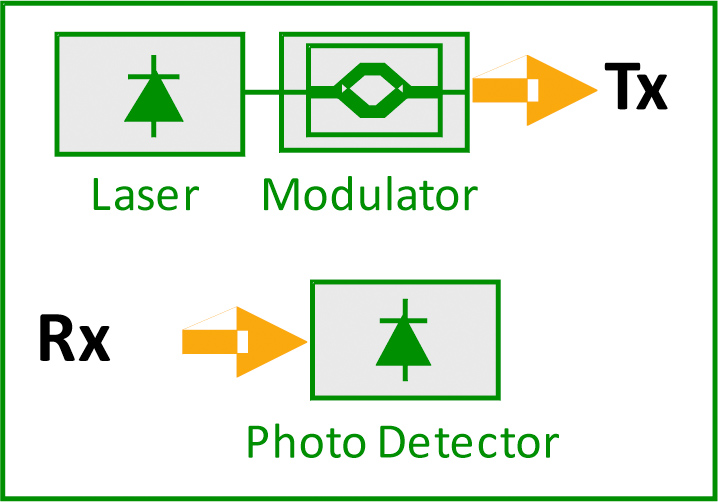 |
|
OOK Transmitter And Receiver Optical Components |
Using OOK modulation at more than 10G line rates, optical impairments begin to severely impact DWDM transport performance. Because these impairments are related to symbol rate rather than to a bit rate, higher-order modulation methods usually are used for 100G wave transport. This effectively reduces the symbol rate while increasing the bit rate and thus minimizes the negative impact of these impairments. Higher order modulation also is spectrally more efficient, which means the information capacity of the fiber is improved as well.
There are many higher-order modulation formats that can be used for optical transport, but those most commonly used today rely on some form of phase shift keying (PSK). Table 1 provides the bits per symbol for common modulation schemes. The more bits encoded per symbol in transmission, the more efficient the modulation format.
Further improvements in spectral efficiency can be achieved using polarization multiplexing on the optical signal. In this case, the transmitting laser’s output is split into two signals, and the polarization of one of these is shifted 90 degrees before modulation. Each signal then is modulated separately and combined at the transmitter output for transport over a single fiber. Figure 2 shows the polarization multiplexed transmitter and receiver.
On the receive side, the incoming optical signal is split into the original two polarized signals using a polarization demultiplexer, and then each is independently demodulated. The two recovered bit streams then are combined to reproduce the original data stream. Polarization multiplexing may be used with any of the common modulation formats; for a given transport data rate, it effectively reduces the symbol rate by a factor of two.
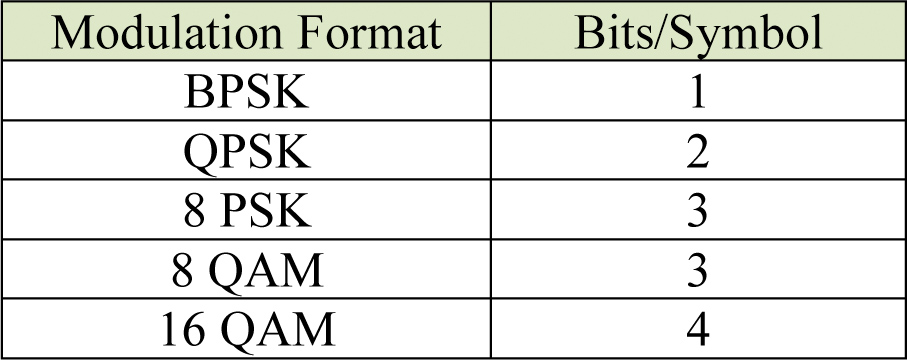 |
| Bits Per Symbol For Common Modulation Formats |
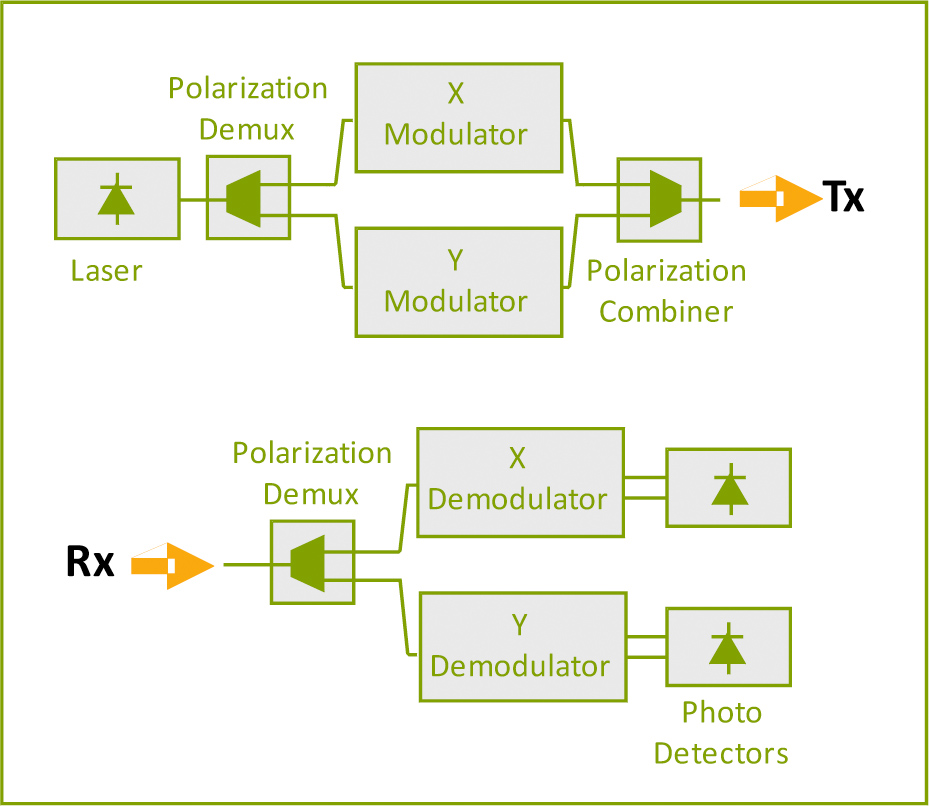 |
| Polarization Multiplexed Transmitter And Receiver |
Most DWDM transport equipment uses QPSK modulation for 100G transport. While QPSK is roughly twice the complexity of BPSK and requires about twice as many components, it represents a good tradeoff between spectral efficiency and OSNR performance. For even better performance, polarization multiplexed QPSK (PM-QPSK) typically is used, though at the expense of increased complexity and component count.
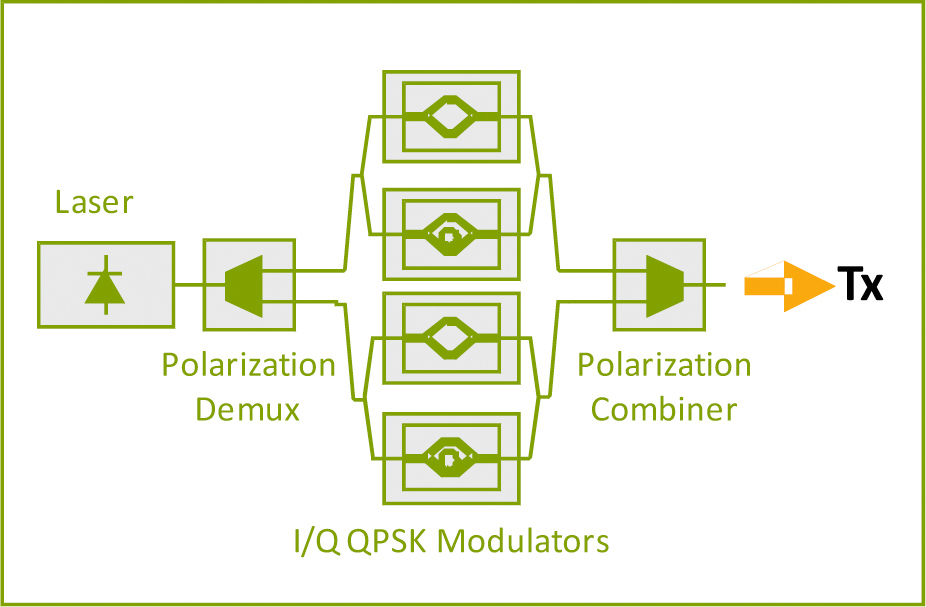 |
| QM-PSK Transmitter Block Diagram |
Figure 3 shows a block diagram of a PM-QPSK transmitter. The source laser signal is split into two polarized sources 90 degrees out of phase. These are then QPSK modulated, creating “I” and “Q” components, and these then are combined for transport on the fiber.
Further performance enhancements can be achieved if coherent detection is used. In differential QPSK (DPQSK), detection is performed by measuring changes in the phase of the received signal rather than the absolute phase itself. DQPSK receivers are much simpler to implement. However, DQPSK receivers provide a lower level of performance that translates into higher BER or shorter reach when compared to coherently detected QPSK. This difference usually is sufficient to justify the use of coherent detection, and the Optical Internetworking Forum (OIF) has standardized on coherent PM-QPSK for 100G transport.
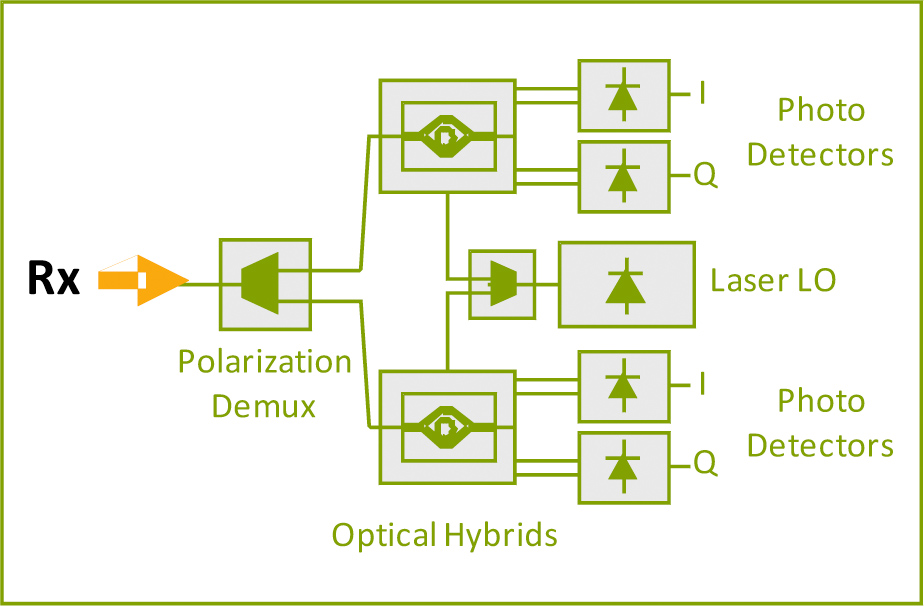 |
| PM-QPSK Coherent Receiver Block Diagram |
Figure 4 shows a block diagram of a PM-QPSK receiver. Coherent detection requires a local copy of the transmitter’s original optical carrier to perform direct phase detection. This requires a separate local laser at the receiver, which is phase locked to the incoming optical signal to create a copy of the original optical carrier.
Coherent detection usually is implemented with an ASIC that integrates the A/D conversion for the optical detectors as well as a DSP, AGC controller and other functions. DSP in the coherent receiver enables other capabilities as well, including electronic dispersion compensation (EDC). EDC is far more tolerant than fiber-based dispersion compensation, and it can readily provide compensation for +/-50,000 ps/nm without the use of dispersion compensation modules. Similarly, PMD performance is greatly improved when coherent detection is used with digital signal processing, and a DGD tolerance of 200 ps peak can be achieved for 100G waves.
Another benefit of DSP-based coherent detection is the ability to provision the modulation format in software. Thus, the transmitter and receiver can be designed to operate using either BPSK or QPSK, and the operating mode may be selected based upon link requirements. BPSK supports longer reach at a lower data rate for ULH applications, where QPSK is optimized for higher data rates with some compromise in reach.
Photonic Integration
Comparing the number of components required for OOK and PM-QPSK transmission, it is apparent that a significant number of additional optical components and fiber connections are required per lambda to support 100G transmission. If one considers transmission of 80 x 100G lambdas per fiber, the number of required additional components and fiber couplings is quite large. This has a direct negative impact on reliability, power consumption, space and cooling requirements, all of which lead to higher transport costs.
Fortunately, technology is available to mitigate the increased complexity and component counts required for higher-order modulation. Modern photonic integration allows multiple optical subsystems to be manufactured monolithically on an Indium Phosphide (InP) chip using large-scale integration. It is possible today to put all the optical components necessary to support multiple lambdas, including mux/demux functions, on a single photonic integrated circuit (PIC) and address integration at the system level rather than at the component level.
PICs supporting OOK modulation for multiple 10G waves have been commercially deployed since 2005, and they support 10 x 10G wave transport on a pair of PICs smaller than 5 mm square each (complete TX and RX systems). PICs that support 5 x 100G DWDM wavelengths using PM-QPSK modulation and coherent detection already have been demonstrated in long-haul networks, and they are planned for commercial availability in DWDM systems in 2012.
PICs provide the unique benefit of integrating not only the discrete optical components, but the optical connections between them. Table 2 shows the number of PM-QPSK functions integrated on 5 x 100G TX and RX PICs, the number of equivalent discrete component “gold box” packages eliminated and the number of fiber connections eliminated. This represents a major improvement in fiber coupling and discrete component reduction when compared to today’s discrete 100G implementations.
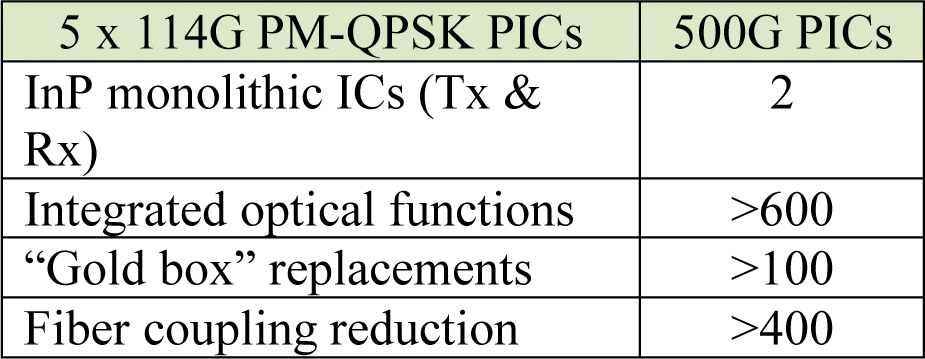 |
| PM-QPSK Coherent Receiver Block Diagram |
Moore’s Law indicates significant improvements are yet possible in future generations of PICs, and 10 x 100G terabit PICs already have been produced and have been tested successfully in the lab. Current models predict PIC bandwidth will double about every three years, keeping pace with bandwidth growth while lowering the overall cost per bit.
Multi-Carrier Super-Channels
As the industry migrates to terabit optical transport, there will be an increasing need to squeeze more bandwidth from fiber. Modulation formats will continue to evolve, with 8 QAM and 16 QAM being next in line for expanding transport bandwidth. At the same time, it is desirable to retain the flexibility to support multiple modulation formats on the same fiber, which will allow seamless migration to higher bandwidth.
Current DWDM systems are based on the ITU grid that provides lambda spacing of 100 GHz, 50 GHz or 25 GHz. Inherent in this spacing are dead zones to allow optical filtering of individual waves, and these dead zones limit channel density, which can result in as much as 50 percent of the available fiber spectrum being unusable.
In the future, it will make more sense to move beyond the current ITU channel plan and implement multi-carrier super-channels that eliminate the dead zones within the super-channel while preserving a guard band at the edges of each super-channel for filtering purposes. Multiple sub-rate carriers can be implemented readily within the super-channel using PIC technology, which also allows multiple modulation formats and flexible channel spacing to be supported and provisioned in software. Such DWDM systems should enable transport capacities of as much as 25 Tb/s per fiber, well-beyond the capacity of today’s systems.
What It All Means
As transport bandwidth requirements grow 50 percent to 100 percent annually, DWDM transport systems will have to migrate to complex modulation to increase the transport capacity per lambda. Complex modulation requires substantially more optical components per lambda than current 10G transport lambdas require. This growth in components isn’t sustainable in the long run due to the increased cost, space, heat, power and reliability requirements associated with discrete implementations.
Photonic integration, which combines on a chip the entire optical subsystems needed to transport multiple lambdas using complex modulation, provides a scalable technology that enables future migration to terabit PICs, which will lower overall transport costs while reducing space, power and cooling requirements.
Gaylord Hart is director/MSO Market Segment at Infinera. Contact him at ghart@infinera.com.
>>References
“Evolving Optical Transport Networks to 100G Lambdas and Beyond,” Gaylord Hart, Infinera, 2011 Cable Connection Spring Technical Forum Conference Proceedings, June 2011.